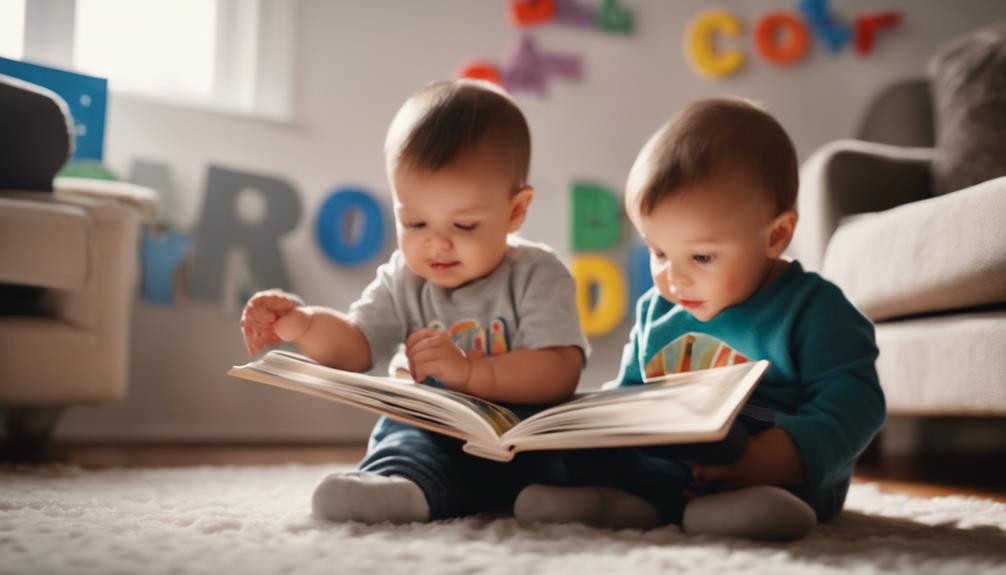To effectively engage your baby with reading, begin by choosing books that are designed for babies with vibrant illustrations, high-contrast images, and durable materials such as cloth or board. Incorporate interactive elements like puppets, mirrors, and textured books to capture their attention. Establish a cozy reading routine in a designated area, making it a daily bonding activity. Utilize different voices, point out objects, and use props to make the experience more engaging. Expand their vocabulary by repeating words, explaining new ones, and discussing the illustrations. By following these suggestions, you can boost your baby’s development and strengthen your bond through the joy of shared stories. Following these guidelines will help you enhance your interactions with your little one even further.
Key Takeaways
- Use interactive books and props for engagement.
- Establish a cozy reading routine daily.
- Encourage participation by asking questions.
- Create a positive reading environment.
- Build vocabulary by repeating words and defining them.
Benefits of Reading to Babies
Reading to your baby early on has numerous benefits that can positively impact their development and future reading habits. When you engage in reading to babies, you aren't only introducing them to language but also fostering a significant parent-child bond.
This interaction plays an important role in language development since babies start understanding language before they can even speak. The more words a baby hears during these reading sessions, the more words they'll gradually learn over time. Additionally, reading to babies helps them develop essential listening skills and stimulates their brain development.
Through the simple act of reading to your baby, you're laying a foundation for their future literacy skills and nurturing a love for reading. These early experiences with books create a positive association with reading, increasing the likelihood that your child will continue to enjoy and engage with books as they grow older.
Embrace this precious time spent reading with your baby as it not only shapes their language abilities but also strengthens the special bond between you and your little one.
Choosing Baby-Friendly Books

When selecting baby-friendly books, focus on bright illustrations that captivate your baby's attention. Opt for high-contrast images that are easier for young babies to see and engage with, supporting their early visual development.
Consider books made of cloth, soft plastic, or sturdy board books with durable cardboard pages that are perfect for babies to explore and handle. These materials make it easier for little ones to turn pages and interact with the book, enhancing their sensory exploration.
Board books, specifically designed for babies, are robust and can withstand the wear and tear of curious hands. Choose books with simple, bold illustrations that are visually stimulating and appealing to your baby's developing senses.
Interactive Reading Techniques

To enhance your baby's reading experience, incorporate interactive reading techniques that engage them through touch, sound, and movement. Interactive reading to young children involves more than just reading the words on the page. It's about creating an immersive and stimulating experience that captivates their senses and encourages active participation. One way to achieve this is by using props like puppets, mirrors, or textured books to make the story come alive. Encouraging your baby to turn the pages, point to pictures, or ask questions about the story can also enhance their engagement and comprehension. These interactive activities not only foster a love for books but also help in the development of sensory skills, language comprehension, and cognitive abilities.
| Interactive Reading Techniques | Description | Benefits |
|---|---|---|
| Using puppets | Incorporating puppets to act out the story | Encourages imagination and engagement |
| Mirrors | Placing mirrors in the book for self-recognition | Promotes self-awareness and interaction |
| Textured books | Books with different textures for tactile exploration | Enhances sensory development and engagement |
Creating a Reading Routine

When establishing a reading routine with your baby, it's crucial to set a daily schedule and choose a cozy spot for your reading sessions.
By creating a consistent time each day for reading, you can help your baby develop healthy sleep patterns.
Developing a special reading routine can also help your baby associate books with comfort and relaxation.
Set Daily Schedule
Establishing a daily reading schedule for your baby can help create a consistent routine that promotes bonding and enhances your child's attention span. Reading at the same time each day, whether it's before naptime or bedtime, can signal to your baby that it's time to wind down and enjoy a story.
This structured routine not only provides a sense of anticipation and comfort for your baby but also helps improve their focus during story time. By incorporating books into your daily schedule, you're setting the stage for quality bonding time with your little one.
Regular reading sessions offer a dedicated opportunity for you to connect with your baby through the magic of storytelling. So, grab a book, find a cozy spot, and make reading a cherished part of your daily routine. Remember, consistency is key when it comes to nurturing your child's love for reading and building a strong parent-child relationship through shared stories.
Choose Cozy Spot
Select a warm and inviting spot for your reading sessions to create a cozy environment that enhances your baby's engagement with the story. Establishing a designated reading area can help your baby associate reading with comfort and security, promoting a sense of routine. Babies thrive on predictability, so choosing a quiet and cozy spot for reading can enhance their focus and engagement during story time. This special reading spot can also strengthen the bonding experience between you and your baby, making story sessions more enjoyable and memorable. To further guide you in creating the perfect reading nook for your little one, refer to the table below:
| Cozy Spot Ideas | Description |
|---|---|
| Snuggly armchair or rocking chair | Provides a comfortable and soothing seating option for you and your baby. |
| Soft rug or blanket on the floor | Offers a cozy space for tummy time while reading together. |
| Bean bag chair or floor cushions | Creates a relaxed seating area perfect for interactive reading sessions. |
Reading Milestones by Age

As your baby grows, they'll reach different reading milestones based on their age. For infants, it's important to start with chunky board books, fabric books, or vinyl bath books that engage their senses. This helps in developing their sensory skills and lays the foundation for future reading habits.
Toddlers aged 9-18 months typically enjoy board books with simple stories and repetitive phrases as it encourages interactive reading. It's a critical time when your child learns to associate words with pictures and begins turning pages with your assistance.
As toddlers reach 18-36 months, introducing longer stories with complex plots and humor can enhance their comprehension skills. Encouraging them to participate by turning pages or pointing to pictures aids in their cognitive development. Active toddlers benefit from incorporating movement into storytelling to maintain their interest and engagement.
Additionally, repetition plays a key role as toddlers enjoy hearing the same stories multiple times, reinforcing their learning and understanding of language.
Making Reading Fun for Babies

How can you make reading enjoyable for your baby? When reading to your little one, it's essential to engage them actively to create a fun and interactive experience. One way to achieve this is by using books specifically designed to captivate infants. Consider interactive books with textures, mirrors, or puppets that stimulate their senses and keep them engaged. High-contrast images and minimal text are also great choices to grab their attention and support visual development.
To further enhance the reading experience, encourage participation by acting out stories, making sounds, and asking simple questions. For example, you can ask your one-year-old questions like, "Where is the dog?" or "Can you point to the red balloon?" This not only makes reading more fun but also helps develop their listening skills.
Here's a handy table to summarize some ways to make reading enjoyable for your little one:
| Tips for Making Reading Fun |
|---|
| Use interactive books with textures, mirrors, or puppets |
| Choose books with high-contrast images and minimal text |
| Encourage participation by asking questions and acting out stories |
Frequently Asked Questions
How Should You Read to Your Baby?
When you read to your baby, use age-appropriate books with engaging features like textures and mirrors. Encourage interaction by asking questions and making sounds. Reading fosters bonding and boosts cognitive development in your little one.
What Is the Hardest Month of the Baby's First Year?
The hardest month of your baby's first year can vary, but many parents find the fourth month challenging due to sleep regression and increased fussiness. This period of significant growth and development can be tough to navigate.
How to Be a Good Parent to a Baby?
To be a good parent to a baby, spend quality time engaging with them daily. Show love, provide a safe environment, and be patient. Read to them, play, and talk often. Trust your instincts, seek support when needed, and enjoy the journey.
What Advice Would You Give to the Parents of a New Baby?
For new parents, embrace the joy and challenges of raising a baby. Prioritize bonding, communication, and creating a nurturing environment. Remember, you are shaping a little life with your love and care. Trust your instincts and seek support when needed.
Conclusion
To sum up, reading to your baby is a beneficial activity that can help with their cognitive development and language skills.
By choosing baby-friendly books, using interactive reading techniques, and creating a reading routine, you can make the experience enjoyable for both you and your little one.
Remember, reading milestones vary by age, so be sure to adapt your reading style accordingly.
Ultimately, making reading fun for babies can set them on the path to a lifelong love of learning.









